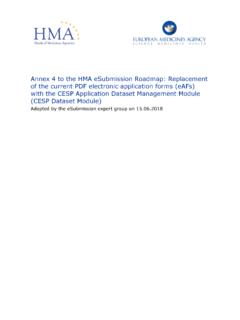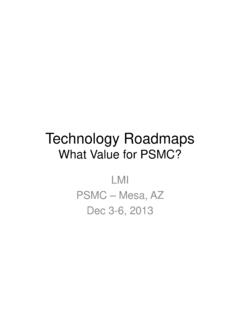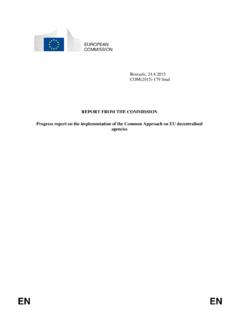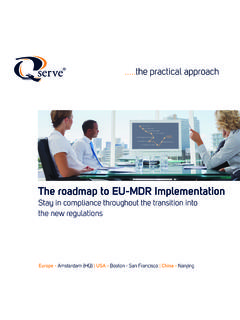Transcription of Developing and Implementing Roadmaps – A Reference Guide
1 (814) 863-7133 E-mail: College of Information Sciences & Technology The Pennsylvania State University102H IST Building University Park, PA 16802 Irene J. Petrick, Professor of Practice and Director, Enterprise Informatics & Integration Center (EI2) Developing and Implementing Roadmaps A Reference Guide PART 1: INTRODUCTION TO ROADMAPPING Roadmaps TAKE MANY FORMS, BUT THERE ARE SOME common ELEMENTS IN THE PRODUCT DEVELOPMENT SPACE A roadmap (the noun) is a graphical representation of the interaction of multiple forces over time, generally aimed at technology, markets or product development platforms. A roadmap is an information organizing framework that brings together diverse issues into a common view. Basic ResearchProgramsApplied ResearchProgramsTechnologyRoadmapProduct RoadmapMarket RoadmapBR1AR1P1P2BR2T1T3T2P3BR3P4AR2BR4B R5AR3P5 Market 1 Market 2 TIMET echnical Specialist InputExecutive InputsExecutive & Specialist InputIntegrated into common roadmap FrameworkBasic ResearchProgramsApplied ResearchProgramsTechnologyRoadmapProduct RoadmapMarket RoadmapBR1AR1P1P2BR2T1T3T2P3BR3P4AR2BR4B R5AR3P5 Market 1 Market 2 TIMET echnical Specialist InputExecutive InputsExecutive & Specialist InputIntegrated into common roadmap FrameworkFigure 1: Roadmapping Captures Both Strategic and Tactical Aspects When we refer to Roadmaps we are often speaking of a set of Roadmaps rather than a single effort.
2 In Figure 1 we see a composite roadmap that captures in a single graphic activities and issues that are happening across several silos within a traditional organization. Here we see that basic research programs roll up into applied research programs that support specific technology solutions. Note that the BR and AR programs feed into the Technology platforms (T) and technology roadmap in terms of time. This is to insure that the technology is ready for the product when it is needed in essence managing any technology that might be on the critical path. But the product roadmap the set of product offerings and their migration over time to a new platform (from grey to white above) is really the result of the combined influence of the technology opportunities and the market gaps.
3 In the example above, two different product platforms are envisioned to support two different markets. In reality, this may actually be a gradual transition. Roadmapping (the verb) is the process whereby companies bring together a diverse group of staff to consider how different aspects of the internal and external environments will interact and influence the product portfolio choices. Roadmapping and Roadmaps are distinctly different from project planning and project plans (aka, Microsoft Project). In project planning and project plans, the emphasis is on execution to completion, with a focus on tasks and resource management. Though there are multiple forms that Roadmaps can take, there are some common traits. First, in roadmapping, companies are seeking to decompose complex systems into subsystems and ultimately into elements.
4 It is the elements that are represented on the roadmap . In this way, the elements can change individually and we can see the impact that an element change will have on the outcome and/or timing of the more complex system. When the complex systems are decomposed, it is often done along functional lines. In Figure 1, for example, the information is organized in functional layers such as marketing and technology, with technology further subdivided into basic and For many companies, the technology roadmap emerges based on technology forecasts, supplier information, other industry Roadmaps , and technology developments in key supporting industries. In the technology roadmap , companies seek to capture the capabilities and timing of different, often competing, technology solutions.
5 The market roadmap is derived from key user Roadmaps if the company is a supplier then it can gain insight from Roadmaps that its customers might create and share, from general demographics, customer feedback, governmental regulation, and global competition in the product space. Roadmaps FACILITATE COMMUNICATION AND DECISION-MAKING Recently a director of R&D at Proctor & Gamble, Inc. likened strategic planning in the product development space to having a He distinguishes two types of conversations one about possibilities and the other about action. The goal of these conversations is to create a common view of the opportunity space and then to create a common understanding of the best path forward. This distinction is quite relevant to roadmapping and Roadmaps .
6 Roadmapping helps different individuals in the company discuss their view of the possibilities. Because it is an information organizing framework, a roadmap quickly helps these different individuals find linkages, common ground, and differences of opinion. Duane Oda, Product Development Chief in Boeing Commercial Airplanes (BCA), noted that the roadmapping process changes both the caliber of discussions and the In his experience with roadmapping over the past several years, roadmapping has enabled BCA to consider opportunities and possibilities with its suppliers and with its customers. These in turn have informed design. Ultimately, roadmapping and Roadmaps should help units within the company articulate what they will do in the context of the organization s goals and objectives.
7 In this sense, roadmapping and Roadmaps help to link actions with strategic intent. Nowhere is this more crucial than in the technology development arena, where there is uncertainty around how to translate high level product requirements into technical approaches and activities. Here, R&D managers are deciding whether or not existing technology solutions can be adapted to near and longer term needs or, conversely, whether new investments in research are necessary to develop a new solution. Often this decision is paired with the Make versus Buy decision should the company invest in its own technology or partner with or acquire a company that 1 For a comprehensive description of the different forms that Roadmaps might take, see Phaal, R.
8 , Farrukh, , and Probert (2004) Technology roadmapping A planning framework for evolution and revolution, Technological Forecasting and Social Change, 71: 5-26. 2 Personal conversation at the Innovation Future Forum, Cincinnati, OH, October 2-4, 2007. By-invitation forum sponsored by Boeing and Proctor & Gamble, Inc. 3 Personal conversation. Irene J. Petrick. Please do not reproduce without approval and attribution. 2 already possesses a similar solution or capability. Figure 2 below highlights the different types of Roadmaps that typically emerge and the way that these Roadmaps feed into the strategic and operational decision-making processes of most companies. Basically there are three types of Roadmaps : 1. Assessment Roadmaps capture key elements of particular issues like the market, technology, product or other basis for competition.
9 Assessment Roadmaps reflect the lay of the land around a particular issue and the horizontal layers in these Roadmaps are generally unrelated to one another. Instead the common element is time. 2. Composite Roadmaps capture the relationships between competitive issues and thus the relationships between the layers is critical. Here is where we begin to align activities in one area with those in another. Often companies use composite Roadmaps to think about alternative sets of actions that might support strategic initiatives. 3. Finally, operational Roadmaps are where we translate the strategic intent that is captured on the composite roadmap into individual operating unit plans that can then be executed and managed through various processes.
10 Map the Lay of the Land(Where are we now)Long Term Goals(Where do we want to be)Map the Lay of the Land(Where are we now) Figure 2: Different Types of Roadmaps Feed into Company Decision-making Processes Roadmaps help companies to determine where they are now in the context of important market and other drivers. These lay of the land maps can then feed into the strategic planning process to help inform what stretch goals the company might choose to pursue. Strategic planning is informed by roadmapping as companies begin to think about their goals in the context of composite Roadmaps that capture all of the necessary actions, investments, partnerships, and other issues that might be needed to achieve these stretch goals. Ultimately choices must be made between the alternatives presented in composite Roadmaps during the strategic planning process.









